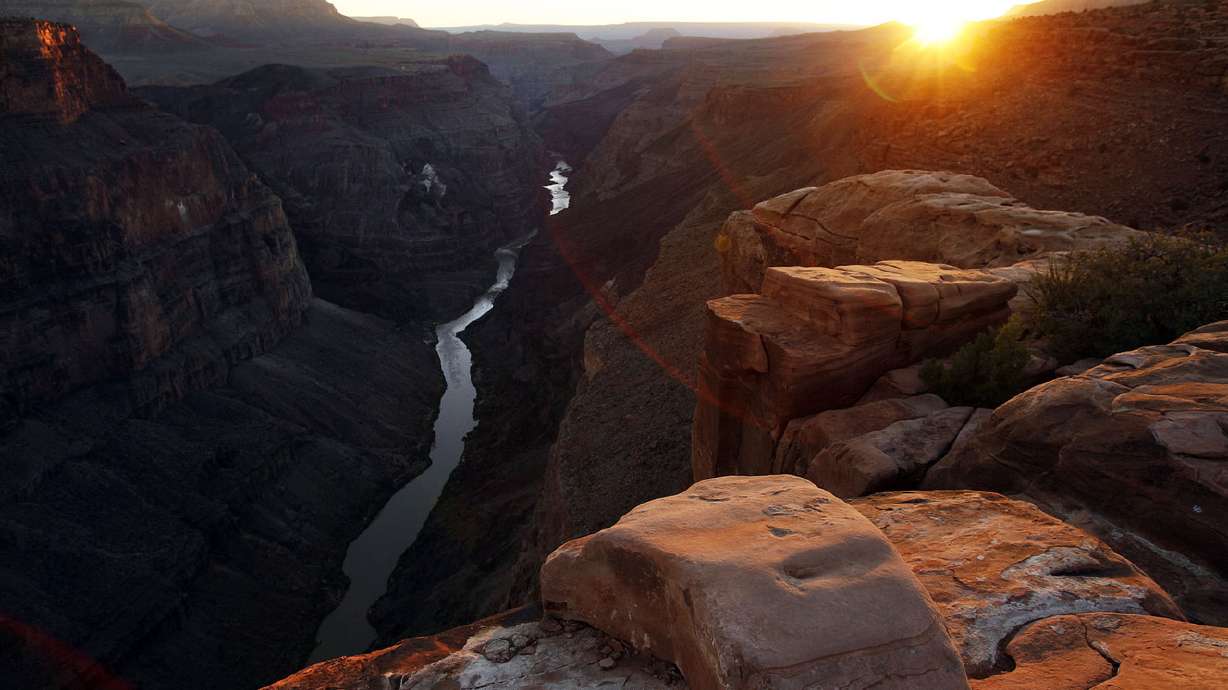Estimated read time: 4-5 minutes
This archived news story is available only for your personal, non-commercial use. Information in the story may be outdated or superseded by additional information. Reading or replaying the story in its archived form does not constitute a republication of the story.
SALT LAKE CITY — A new study touted as the first of its kind explores the financial perils to the region — and to each state in the Colorado River system — if the water ran dry for a full year.
Commissioned by Protect the Flows, a business coalition advocating on behalf of the river, the study by Arizona State University detailed impacts to gross state product, employment and labor income in each of the seven states that rely on Colorado River water, including Utah.
The study released Thursday found that the Colorado River generates $1.4 trillion in economic benefits annually, and $871 billion in annual labor income is in jeopardy should Colorado River water become unavailable to industry, businesses and agriculture.
Taking out the river means taking out an estimated 64.4 percent of the combined value of each basin state's output of goods and services.
"We've long suspected the impact of the Colorado River to be quite large, but the results of this study help to quantify it," said university economics professor Timothy James, lead author of the study. "The detailed analysis reveals how deeply intertwined the economy of the region is with the river's health."
Utah's impacts are far overshadowed by states such as Arizona and California — with river-dependent gross state products of $185 million and $657 million respectively — but the impacts are nevertheless telling.
For the Beehive State, nearly half of the value of the gross state product — $34.6 billion — would be lost in the absence of Colorado River water for just one full year.
The study shows that direct losses to Utah's economy stand at 483,000 jobs and nearly $22.2 billion in labor income. Utah gets an estimated 22 percent of its agricultural water from the Colorado River, and 34 percent of its municipal and industrial water supplies come from what's been called the "Nile" of the West.
#photo
"We have many studies on the value of water to single economic sectors, such as agriculture or outdoor recreation, but the time has passed to take such a narrow view of the importance of water," said Jody Williams, a Protect the Flows board member and a Salt Lake City-based attorney who heads up the water division for the law firm of Holland & Hart. "This is a comprehensive study of the total economic output and value of the Colorado River. It recognizes that our economy is sophisticated and interrelated. Water sustains us and drives our economy in every sector."
Using the dramatic scenario of the river drying up for a year, the study of the 1,450-mile river that serves 40 million people attempts to quantify its economic value to the combined basin region and to individual states.
The backdrop for the study is found in the vast challenges to the river that have been brought on by persistent drought and over allocation of its resources that experts warn is unsustainable.
In 2012, the U.S. Bureau of Reclamation released a groundbreaking study that looked at imbalances between supply and demand on the Colorado River, going out 50 years. It concluded there would be significant shortfalls and used the study's findings as a call to action for states and users along the system.
This latest analysis commissioned by Protect the Flows grew out two Business of Water Corporate Leader summits in 2013 and 2014, when hundreds of businesses and water leaders met to identify and share best practices and private-sector solutions to water conservation and supply issues.
"It's clear from this report that the Colorado River generates significant value for every state in the Southwest," said Ann Tartre, director of corporate partnerships for Protect the Flows. "All the states, along with water users in every sector, need to work together to keep this vital resource flowing for future generations."
#caption
Among the private sectors in Utah taking the biggest hits under a no-water scenario were real estate and rental businesses, the finance and insurance industry, and health care and social services.
By far the biggest job losses in Utah if the Colorado River dried up for a full year would come from the government sector, which is estimated to lose nearly $9.4 billion in direct, indirect and induced losses.
One observation noted by the study authors is the lack of current and consistent information on Colorado River flows.
Both the U.S. Geological Survey and Bureau of Reclamation approach measurement of the resource in different ways — one examining withdrawals and the other looking at consumptive uses.
The report noted that given the concerns over the availability of water in the region, it is reasonable to expect a more frequent, reliable and consistent set of information about the river.
Much like the U.S. Energy Information Administration publishes an annual outlook with projections that serve as a starting point for potential policy changes, the report noted that inconsistent data collection prevents that for the Colorado River system and its users.








